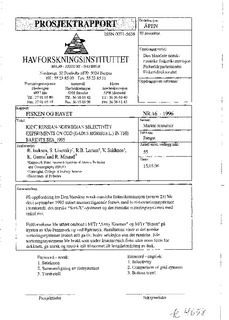| dc.description.abstract | With reference to point 4.3.2 in the protocol from the 23rd Session of the Mixed Norwegian-
Russian Fisheries Commission, the parties agreed that necessary testing of sorting grids systems
had to be performed during 1995 in order to enable the Fisheries Comrnission to reach a decision
on the introduction of grid systems in the trawl fishery for cod in the Barents Sea.
During the period 15-27 September 1995, joint Russian-Norwegian selectivity experiments with
sorting grid systems were carried out in the Barents Sea on board the Russian vessel "Bizon" and
the Norwegian vessel "Anny Kræmer".
Two different grid systems were used, both with an inter-bar distance of 55 mm. The Norwegian
vessel used predominantly the 4.5 m semi-rigid "Sort-X" system, while the Russian vessel used
a 1.5 m single-grid system. In a few tows the Norwegian vessel used a single-grid system
mounted in a two-panel Alfredo-type trawl.
The experiment were divided into four periods. By assistance from the Norwegian vessel during
the first period, the Russian trawl was observed by an underwater vehicle carrying video camera.
The single-grid system appeared to perform as anticipated. Underwater observations of the singlegrid
system in the Norwegian trawl revealed poor performance, and it was reinstalled to give a
better performance.
Comparative fishing trials in the second period with covers and blinders gave almost similar 50%
retention values for "Sort-X" used in the Norwegian trawl and the Russian single-grid system in
the russian trawl, with L50 of 50.3 and 49.7 cm, respectively. The "Sort-X" system gave a
somewhat sharper selection, with a selection range of 11 cm compared to 15 cm for the singlegrid
system. Both systems had a very good release of small fish; with an escape rate for fish
smaller than 42 cm of 93-94% and of fish smaller than 47 cm of 88-89%.
During the third period, single-grid systems were used on board both vessels. This system worked
as before for the Russian trawl, but did not work properly with the Norwegian Alfredo-type trawl.
Although a good performance during UTV-observation, the selectivity experiments revealed that
the single grid in the Norwegian trawl had a low angle of attack, and that far from all fish were
brought into contact with the grid.
During the fourth and perhaps the most important stage of the experiments, the trawls were rigged
as during commercial fishing, with a single-grid system and a 135 mm codend in the Russian
trawl, and the "Sort-X" system and a 135 mm twin-codend in the Norwegian Alfredo-type trawl.
The size distribution from the five parallel tows were not significantly different. Analysis of data
from hauls with and without blinder revealed a slight codend selection in the Russian trawl aft
of the single-grid system and minor or no codend size selection aft of the "Sort-X" system.
The two grid-systems tested during these experiments have both their benefits and drawbacks
regarding selectivity, handling and expenditure aspects. The grid systems as used in the respective
trawls with ordinary codends give a close to similar selectivity, and will undoubtedly improve the
overall size selectivity of bottom trawls.NORSK SAMMENDRAG:På oppfordring fra Den blandete norsk-russiske fiskerikommisjon (sesjon 23) ble
det i september 1995 utført sammenlignende forsøk med to ristsorteringssystemer
i torsketrål, det norske "Sort-X"-systemet og det russiske sorteringssystemet med
enkel rist.
Feltforsøkene ble utført ombord i MRr "Anny Kræmer" og MITr "Bizon" på
kysten av Øst-Finnmark og ved Bjørnøya. Resultatene viser at det norske
sorteringssystemet isolert sett ga litt bedre seleksjon enn det russiske. Når
sorteringssystemene ble brukt som under kommersielt fiske uten noen form for
dekknett, ga norsk og russisk trål tilnærmet lik lengdefordeling av fisk. | en |
